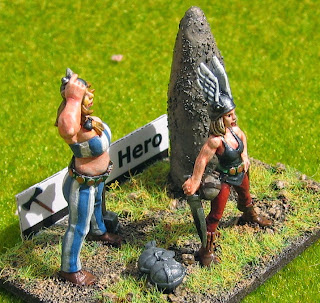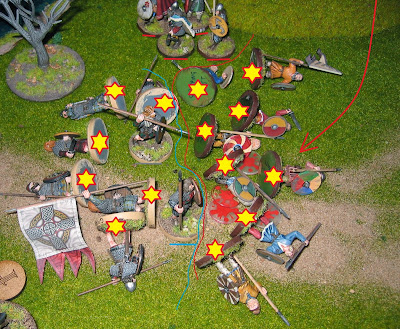Introduction
I've had my Mystery Inc team (also known as the "Scooby Doo gang") for some time. These are 28mm models from Hasslefree and are, I think, fairly widely known about by those with an interest in such matters. However, what about their ride? The team need a vehicle.
In the original cartoon show they had an iconic van with an instantly recognisable colour scheme. Oddly, there are many imitations and variations of this paintjob applied to a number of different types of real life vans - just google for "Mystery Machine" images. These are owned by fans, re-enactors (?!) or (more likely) professional entertainers with reasonable budgets.
But what about 28mm models? Well, there are several choices for the Mystery Machine. Most commonly recommended are toy vehicles, but I find such toys to be badly scaled, often quite goofy-looking and frequently out-of-production and hard to find. But there's another choice...
Another Option
Hidden away on the Crooked Dice website, listed under 'Heroes' (I think), is a 28mm model of a Transit van. This clearly fits into the "cops and robbers" category of Crooked Dice's 7TV game, as the example paint jobs show.
But there is a US manufacturer called Company B who produce - amongst other things - decals for some fairly off-beat models. For example, they make "police phone box" markings suitable for a Doctor Who Tardis as well as tank insignia suitable for the Japanese "Girls und Panzer" cartoon show (and if that isn't weird then I don't know what is!)
What's significant for my purposes here is that Company B produce Mystery Machine decals to fit the Crooked Dice van. Yay! So, at the Carronade show earlier this month I went to the Crooked Dice stall and bought a van. An online purchase from Company B was delivered very quickly and I was in business. Here we go!
The Crooked Dice Van
So, the Transit van comes as a resin body with 4 metal wheels and a small sprue of accessories. I wouldn't be using the police light or siren, so I needed only the mirror stalks from the accessories. The wheels have a guide on the backs of them that lines up with the resin body so that they fit at just the correct depth; this is a nice touch.
It took but moments to glue all the parts together. On the whole they were well cast and required virtually no cleanup, but I was disappointed to find a significant air bubble in the resin, located just on the edge of a front wheel arch. I probably spent more time repairing this defect and restoring the body shape around this area than I did with the rest of the construction.
After undercoating, I painted the body of the van with pale blue, then gave it a wash of a medium blue. This is essentially a cartoon vehicle, so I didn't plan on a lot of weathering or details such as a numberplate!
The doors and windscreen were outlined with a very dark grey. The same colour was used to paint the tyres, radiator vents and wheel arches. These latter were exceptionally difficult, since there wasn't really enough space for a paintbrush and I did wonder if I should have painted the wheel arches before gluing on the wheels.
A silver colour (Humbrol aluminium enamel) was used for the hubcaps, bumpers (fenders if you're from the USA), door handles, headlamps, mirror stalks and radiator grill. For really shiny, chrome-like effects I still prefer to use this Humbrol enamel paint, though pretty much everything else I do is in acrylic paints.
The silver bits were given a very thin black wash; this is most evident on the wheels. A few extra details were added - the indicator and stop lights - and then it was time to do the windows.
I've not really painted windshields before, so I looked on the internet for references. One that I found especially useful was a Flames of War article called Lumpy's Guide to Windscreens. I tried to follow the "not-so-easy" method and I think it came out quite well. Whoever you are, thanks to Lumpy!
Now for the decals. The Company B decals are designed for this model and for the most part were easy to use. Their target location was fairly obvious and the decals were sturdy enough and came loose from their backing paper easily.
I did have a slight problem with the larger, lower panel decals: they were too long for the bodywork! In order to make them fit, I cut each of these pieces into 2 parts and removed about 2mm of decal from the cut edge. This is visible if you look closely; there is a slight discontinuity in the pattern where the shortened parts meet.
The rear doors caused further issues. In this case, it was because the hinges and handle were raised areas that would prevent the decal from sitting flush with the door. I had to cut a hole for the handle into the right-hand decal and make slits near the upper hinges in both decals in order to make the decorations fit properly.
Conclusion
For the most part, this was a very straightforward model to build and paint. There were a few minor hiccups which required a certain amount of model-making skill to fix, but nothing too bad. This isn't a cheap piece though - neither the Crooked Dice van nor the Company B decals will ever compete in price with the second-hand toy market for Mystery Machines! Still, I'm very pleased with the end result.


















































